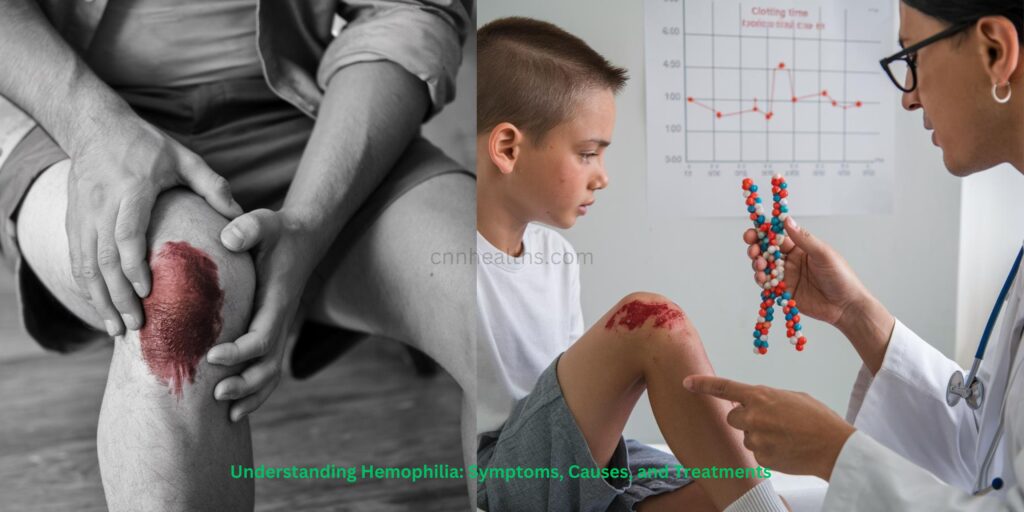Here’s an overview:
- Introduction
- What is Hemophilia?
- Types of Hemophilia
- Facts
- Types of Hemophilia
- Hemophilia A
- Hemophilia B
- Signs and Symptoms
- Causes and Risk Factors
- Genetic Factors
- Familial History
- Sporadic Cases
- Diagnosis and Testing
- Complications Associated with Hemophilia
- Treatment Options
- Replacement Therapy
- Desmopressin (DDAVP)
- Antifibrinolytic Medicines
- Gene Therapy
- Regular Exercise
- Living with Hemophilia: Tips and Advice
- Emerging Research and Future Directions
- Conclusion
Introduction to the Understanding Hemophilia: Symptoms, Causes, and Treatments
Hemophilia is a rare, inherited bleeding disorder in which blood does not clot properly, leading to excessive bleeding from even minor injuries. It predominantly affects males, with females typically being carriers of the disorder. Hemophilia is characterized by a deficiency in specific clotting factors, which are proteins in the blood that collaborate to control bleeding. Clotting factors VIII and IX are most commonly deficient in individuals with hemophilia. Understanding the symptoms, causes, and available treatments for this condition is crucial for managing the disorder effectively and improving the quality of life for those affected.

What is Hemophilia?
Disease where blood doesn’t clot properly) is a rare (related to tiny chemical assembly instructions inside of living things) sickness/problem affecting the blood’s ability to clot. It primarily affects males due to its inheritance pattern linked to the X chromosome. Key characteristics include prolonged bleeding after injury or surgery and spontaneous bleeding into joints, muscles, and organs.
Types of Hemophilia
- Hemophilia A: Caused by a deficiency of clotting factor VIII.
- Hemophilia B: Caused by a deficiency of clotting factor IX.
Facts
- Disease where blood doesn’t clot properly) A is more common than (disease where blood doesn’t clot properly) B.
- Individuals inherit Hemophilia when they receive a defective gene from their mother.
- Diagnosis typically involves blood tests measuring clotting factor levels.
Types of Hemophilia
Hemophilia is categorized into two primary types, each defined by a deficiency in different clotting factors.
Hemophilia A
- Factor Deficiency: Caused by the absence or deficiency of clotting factor VIII.
- Prevalence: It is the most common type, accounting for approximately 80% of hemophilia cases.
- Inheritance: Hemophilia A is typically inherited in an X-linked recessive pattern, primarily affecting males.
Hemophilia B
- Factor Deficiency: Results from a lack or insufficiency of clotting factor IX.
- Prevalence: Less common than Hemophilia A, it comprises about 20% of hemophilia cases.
- Inheritance: Similarly, it follows an X-linked recessive inheritance pattern, predominantly impacting males.
Each type requires specific diagnostic and therapeutic approaches tailored to the deficient clotting factor.
Signs and Symptoms
Hemophilia manifests through various signs and symptoms that may vary in severity depending on the individual and type. Common indicators include:
- Prolonged bleeding from cuts or injuries
- Frequent nosebleeds
- Unexplained and excessive bleeding after vaccinations
- Joint swelling and pain due to internal bleeding
- Large or deep bruises
- Blood in urine or stool
- Unusual bleeding after dental procedures
- Persistent bleeding from minor wounds
Individuals with severe hemophilia may experience spontaneous bleeding episodes, particularly in joints and muscles, even without apparent injury. It is crucial to monitor these signs for early diagnosis and management.
Causes and Risk Factors
Hemophilia is primarily caused by genetic mutations in the F8 or F9 genes, which lead to deficiencies in clotting factors VIII or IX. These deficiencies impede the blood clotting process. Hemophilia is usually inherited through an X-linked recessive pattern.
Genetic Factors
- F8 gene mutation: Leads to Hemophilia A
- F9 gene mutation: Causes Hemophilia B
Familial History
- Inheritance: Males are predominantly affected, while females can be carriers.
- Carrier Testing: Female relatives of a hemophiliac may undergo genetic testing to determine carrier status.
Sporadic Cases
- Rare but can occur due to new genetic mutations.
- Approximately 30% of cases have no family history.
Diagnosis and Testing
Diagnosis of hemophilia involves several critical steps to ensure accuracy:
- Medical History Review: A detailed family and personal medical history to assess potential genetic links.
- Physical Examination: Thorough examination to check for signs of abnormal bleeding.
- Blood Tests:
- Complete Blood Count (CBC): To analyze overall health and detect any blood disorders.
- Prothrombin Time (PT) and Activated Partial Thromboplastin Time (APTT): To measure the blood’s clotting ability.
- Factor Assays: Specifically measure the levels of clotting factors VIII and IX.
Early and accurate diagnosis is crucial for managing hemophilia effectively.
Complications Associated with Hemophilia
Hemophilia can lead to various complications, including:
- Joint Damage: Recurrent bleeding into joints can cause chronic pain and deformities.
- Internal Bleeding: This can be life-threatening if it occurs in critical areas like the brain.
- Infection: Blood transfusions carry a risk of transmitting infections.
- Adverse Reactions: Some patients may develop antibodies that inhibit clotting factors.
- Prolonged Bleeding: Significant blood loss may occur during surgery or after injuries.
- Hematomas: Large bruises from minor injuries can compress nerves and tissues.
- Hematuria: Blood in urine can be painful and indicate kidney issues.
Treatment Options
Replacement Therapy
Replacement therapy involves injecting clotting factor concentrates into the bloodstream. These can be:
- Plasma-Derived Factor Concentrates: Extracted from donated human plasma.
- Recombinant Factor Concentrates: Genetically engineered; not derived from human blood.
Desmopressin (DDAVP)
Desmopressin is a synthetic hormone used to treat mild hemophilia A. It works by stimulating the release of stored factor VIII.
Antifibrinolytic Medicines
Antifibrinolytics, such as tranexamic acid and epsilon aminocaproic acid, help prevent clots from breaking down.
Gene Therapy
Gene therapy aims to introduce genetic material to elevate clotting factor production in the body.
Regular Exercise
Recommended exercises include swimming, walking, and yoga to strengthen muscles and joints but should always be guided by healthcare professionals.
Living with Hemophilia: Tips and Advice
Understanding how to effectively manage hemophilia is essential for maintaining a quality life. Here are some practical tips and advice:
- Medication Compliance: Ensure consistency with prescribed medications.
- Regular Check-ups: Schedule frequent visits to hematologists.
- Exercise Wisely: Engage in low-impact sports like swimming or walking.
- Emergency Plan: Develop a plan with emergency contact information.
- Balanced Diet: Maintain a nutritious diet to support well-being.
Implementing these strategies can promote better health and reduce the risk of complications.
Emerging Research and Future Directions
Emerging research in hemophilia focuses on several key areas:
- Gene Therapy: Researchers are developing gene-editing techniques to correct genetic defects causing hemophilia. Early trials show promise in providing a lasting cure.
- Novel Therapeutics: New medications aim to increase clotting factor production without frequent infusions. Extended half-life products and non-factor therapies are key areas of investigation.
- Regenerative Medicine: Exploring stem cell therapies to repair or replace damaged blood cells holds potential.
- Patient-Centered Care: Innovations in personalized medicine strive to tailor treatments to individual patient needs, enhancing efficacy and minimization of adverse effects.
Conclusion
Understanding hemophilia is essential for proper management and care. Identifying symptoms early, such as excessive bleeding or easy bruising, is crucial. Causes like genetic mutations help in diagnosing and understanding the condition. Treatments range from regular replacement therapy to innovative gene therapy, each offering varying degrees of efficacy. By recognizing symptoms promptly, understanding genetic causes, and utilizing available treatments, individuals with hemophilia can maintain a higher quality of life. Continuous research and advances in medical science promise even better management options, giving hope to those affected by this inherited bleeding disorder.

